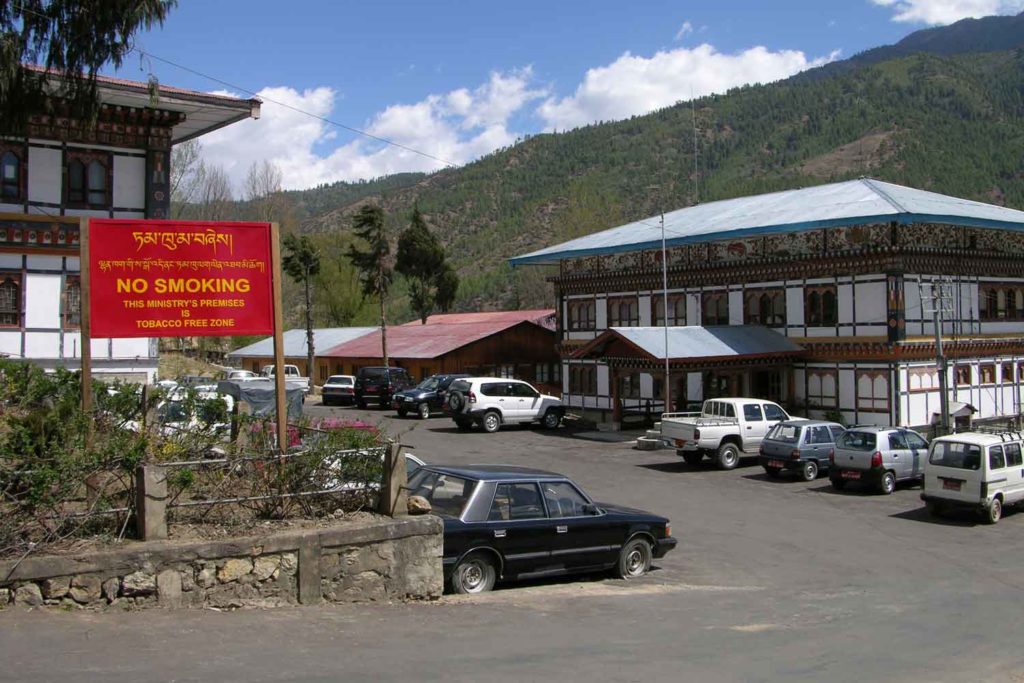The Evil Twins
- Clive Bates Illicit Trade Print Edition
- February 1, 2022
- 0
- 2
- 10 minutes read


Prohibition and illicit trade
By Clive Bates
The remote Himalayan Kingdom of Bhutan was the poster child of tobacco control for many years. It appeared that Bhutan had drawn the obvious conclusion from decades of scientific research and had finally done the right thing. In 2004, the kingdom banned the sale of all tobacco products. Tobacco control activists were delighted.
Jump forward to 2020, and the picture is not so rosy. In a joint report by the government and the World Health Organization office in Bhutan, “The Big Ban: Bhutan’s Journey Toward a Tobacco-Free Society,” Health Minister Dechen Wangmo, sets out the situation: “The black market, one that emerged after the ban, is the number one challenge that Bhutan is faced with when it comes to tobacco control. The Global Youth Survey 2013 reports an increase in the number of school children between ages 13 and 15 using tobacco products. It increased from 24 percent in 2006 to 30 percent in 2013.”
According to the WHO, Bhutan has high levels of ongoing tobacco use despite prohibition. The WHO representative to Bhutan, Rui Paulo de Jesus, provides a candid explanation: “So long as the demand within the country persists, it will continue to fuel the illicit market that has expanded since the ban of its sale in early 2000. Unfortunately, as studies indicate, Bhutanese youth are at the center of this growing illegal trade in tobacco and its products.”
Prohibition as a Perturbation
Unusually for the WHO, the words above contain some essential truths about tobacco policy and prohibitions. The first and most important insight is that while demand for a product persists, a prohibition will just change how the product is supplied. A prohibition does not make a product disappear, even if that’s what politicians and policymakers would like. Instead, a prohibition is a perturbation of a dynamic market: a disruption that reconfigures the behavior of suppliers and consumers, changing who supplies the product, what products are available and under what terms. Prices can go up to reflect the costs and risk of illicit supply. Alternatively, prices can fall as no tax is paid on illicit goods. Illicit commerce is unregulated and ultimately controlled by violence rather than by consumer protection or contract law. An unregulated illegal market creates real dangers to consumers. The 2019 outbreak of severe and often fatal lung disease was caused by adding a harmful additive, vitamin E acetate, to illicit cannabis (THC) vapes as a cutting agent. Arguably, this disaster would never have happened had cannabis vaping products been widely available legally and without excessive taxation.
Participation in Criminal Supply Chains
The second insight is that young people may see the opportunity to make fast money as foot soldiers in an illicit irregular supply chain. It should be a significant consideration in assessing the case for prohibitions supposedly aimed at “protecting kids.” If adolescents want access to the banned products, then a prohibition policy will likely draw young people into the illicit supply chain and an early experience of criminality. Alternatively, the illegal supply of, say, cannabis could diversify to provide prohibited nicotine products as well. For example, in the United States, the Monitoring the Future survey shows that past 30-day cannabis use among 12th grade students has been around 20 percent for the last 25 years. That means there is a ready-made illicit supply chain for providing tobacco or vaping products to young people, should that prove attractive to cannabis suppliers.
Types of Prohibition
Not all prohibitions are as pervasive and straightforward as Bhutan’s. Let’s consider two further categories. First, many tobacco and nicotine policies have a partial prohibition element. By this, I mean the policies are intended to deter the use of the product rather than to protect the user. For example, a ban on flavored e-liquids has a prohibitionist purpose, but a ban on a toxic ingredient in e-liquids has a consumer protection purpose—an important distinction. Caps on nicotine strength or requiring a prescription to access vaping products are partial prohibitions. In On Liberty, John Stuart Mill famously equated taxes on stimulants to prohibition: “To tax stimulants for the sole purpose of making them more difficult to be obtained is a measure differing only in degree from their entire prohibition and would be justifiable only if that were justifiable.”
The United States and New Zealand have proposals to reduce nicotine in cigarettes to a minimal “subaddictive” level. This is essentially a prohibition of cigarettes dressed up as a sophisticated regulatory intervention. Without adequate nicotine, cigarettes are worthless for most users, and they might as well be prohibited. The practical question is what would happen next: Would users quit altogether, move to illicit cigarettes or, for example, switch to vaping? The least likely outcome is any significant or sustained use of low-nicotine cigarettes.
Second, a particular category needs to be defined for the prohibition of products that are beneficial to the user. The snus ban in the European Union has persisted since 1992 despite a mountain of evidence that snus has had a radically positive impact on public health in Sweden and Norway, where it is widely available. There may be arguments for prohibiting harmful products like cigarettes, even if there are doubts about the practicalities, perverse consequences and ethical implications for adult autonomy. But how can anyone defend the prohibition of much safer products that function as alternatives to cigarettes? Yet, there is now a lavishly funded international campaign to do exactly that. The international respiratory health organization The Union is calling for vaping and heated-tobacco products to be banned in all low-income and middle-income countries. That would cover 80 percent of the world’s smokers. This crazy logic is equivalent to campaigners against sexually transmitted diseases pressing for the prohibition of condoms in the hope that it would deter sex by making it more dangerous.
More Enforcement?
Although the WHO’s representative in Bhutan concisely described the problem, he still followed the eternal prohibitionist playbook and called for more enforcement effort. “WHO shares the country’s concerns, and it appears timely that Bhutan embraces the Protocol to Eliminate Illicit Trade in Tobacco Products the country is yet to ratify.”
But this idea, embracing hi-tech track-and-trace technology, seems implausible in the environment of a developing country and an informal economy in tobacco products. Further, more enforcement muscle brings problems of its own. It is expensive, violent and prone to bribery, corruption and abuse of office. Drug prohibition in the United States is notoriously associated with racism. As the Drug Policy Alliance puts it, “People of color experience discrimination at every stage of the criminal legal system.”
Prohibition by Trial and Error
Perhaps the big policy questions cannot be answered until a prohibition has been tried and experience gained? Beware! The danger is that temporary prohibitions may have irreversible effects. Prohibitionists should turn to the 2020 experience in South Africa in which the government banned tobacco sales with a justification based on a Covid-19 response. Research by independent economists at the University of Cape Town concluded that the legal supply had been replaced by illicit supply with a substantial loss of tax revenue. But now that tobacco users have found illegal suppliers to evade prohibition, what is to stop them from continuing to avoid tobacco taxation?
Responsibility and Accountability
One characteristic of prohibition advocates is a reluctance to assess the consequences of their work. The prohibition policy is their real goal, but the real-world consequences are of lesser concern. For example, the UN Office on Drugs and Crime has dogmatically resisted calls to conduct a thorough assessment of the benefits and detriments of the drug prohibition treaties it oversees. This mindset is already evident in the tobacco and nicotine field. In 2019, India’s federal government imposed a comprehensive ban on vaping products. In 2021, the WHO awarded India’s former health minister, Harsh Vardhan, its highest tobacco control medal “for spearheading the government of India’s legislation to ban e-cigarettes and heated-tobacco products”. However, this award was made without any evaluation of the impact of the prohibition on illicit trade, no consideration of the likely perverse consequences leading to more smoking or any reflection on the ethics of denying India’s 100 million smokers lawful access to much safer alternatives.
Proposals for prohibitions, in all their forms, need a much stricter assessment of the likelihood of illicit trade, perverse but easily foreseeable consequences and the ethics of using the force of law to control individual risk behaviors. That has been a conspicuous failure with illicit drugs and alcohol. Let’s hope that policymakers learn those lessons and don’t repeat the mistakes with nicotine.
Finally, a postscript. Following a temporary lifting of Bhutan’s tobacco ban in 2020 for Covid-19-related reasons, Bhutan’s National Assembly passed the Tobacco Control (Amendment) Bill 2021 and Tax Bill of Bhutan 2021. This lifts the ban and legalizes the selling, buying, possession, distribution and transportation of tobacco and tobacco products. The signature prohibition of tobacco control has officially failed.


